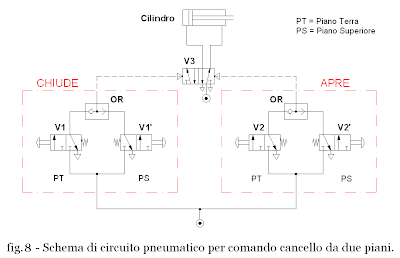cycles. The diagrams tires so far seen the signs that have generated the movement of mechanical parts were produced by manual controls outside the process of opening and closing the gate.
DEFINITION
A process is called automatically when the signals are generated that implement the same process.
From the above definition we can deduce that the systems examined above are not automatic.
single automatic cycle
Suppose we want to build a circuit where the touch of a button, leave the stem of a cylinder, which completes its run, and then come back. In this case the return signal is generated from the stem of the stem itself. This process is called single-cycle . It is useful for the preparation of the scheme, dividing the cycle into phases and determine the signals that activate the drafting of the prospectus cons (Table 7).
Table 7 - Overview of the automatic cycle A +, A-. 
Con A + indicates the output phase of the stalk with the A-phase Return of the stem and A +, A-indicates the complete cycle. S is the signal coming from the start button, the A0 signal switch input of the stem and the A1 signal switch out the stem. The above statement should be interpreted as follows:
To realize the circuit so we need:
For the construction of the scheme must first place components from top to bottom and then trace the connections:
1. You draw the actuators;
2. It indicates the position of switches with dashes in the vicinity of the stem;
3. We draw all distributors are signals that switch them;
4. We draw the limit;
5. You draw the buttons;
6. We trace the links.
switches are always drawn in the position to take when the system is at rest. The scheme of the circuit under test is shown in Figure 15.

Figure 15 - Schematic of pneumatic system for automatic cycle single A +, A-.
continuous automatic cycle
The schedule just got to have carried out a single cycle circuit A +, A-and then stop until it is done again on the Start button.
DEFINITION
A cycle is defined as automatic continuous press a start button when it is repeated continuously until it is stopped with an external signal.
order for the cycle becomes continuous is therefore necessary that:
-
the stem after it is returned, automatically succeeds;
-
hold the start signal (S) the cycle continues until a signal arrives Stop.
The above conditions are met by replacing the Start button with a memory circuit composed of two mechanical valves 3 / 2 monostable button controlling a valve 3 / 2 bistable M with its own power (Fig. 16).

fig. 16 - Circuit diagram for continuous automatic cycle A +, A-.
At rest, the limit A0 M is active and the valve closed. Pressing the Start (S) you switch the valve M in AND with A0, A + which generates the switching valve 5 / 2 that exits the cylinder rod A. When the stem is released the switch is activated A1 generating the signal that it transfers the A-5 / 2 valve and the stem part. When the stem is returned limit switch is activated AND A0 which is connected with the valve in M \u200b\u200bwhich has remained open: the cycle can start again. To shut down, press the Finish button (F), it transfers the valve M in the "CLOSED". When the cycle is completed in place, and activates the limit A0 valve M is closed and the system stops.
<-- Previous Post Next Post ->













 Because the gate can be opened by activating V2 or V2 'must be on the limit FC2. Conversely, because the gate will close by activating V1 and V1 'must be on the limit FC1. To achieve these conditions the limit switches and valves must be connected to AND together as shown in Figure 10 in the case of V2 and FC2.
Because the gate can be opened by activating V2 or V2 'must be on the limit FC2. Conversely, because the gate will close by activating V1 and V1 'must be on the limit FC1. To achieve these conditions the limit switches and valves must be connected to AND together as shown in Figure 10 in the case of V2 and FC2. 









 This problem can be solved in different ways and each solution requires the study to be analyzed before the elements necessary to achieve the required functions. For the movement of the gate is necessary that:
This problem can be solved in different ways and each solution requires the study to be analyzed before the elements necessary to achieve the required functions. For the movement of the gate is necessary that: 


